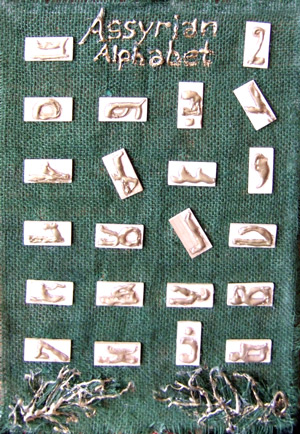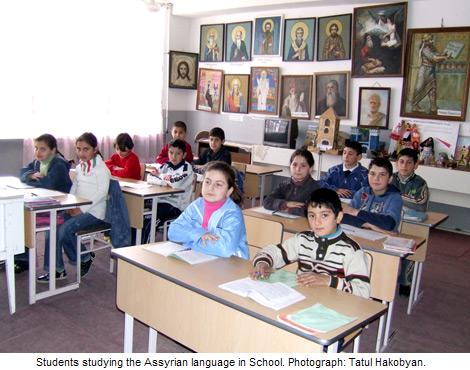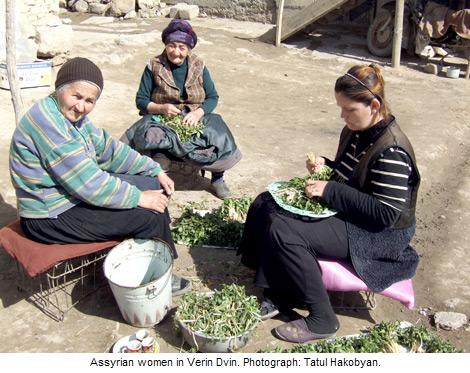

 Verin Dvin, Ararat Province, Armenia -- On April 1 Assyrians throughout the world celebrate the New Year. The Assyrians have been celebrating this holiday for centuries and continue to do so today. When the Euphrates and Tigris overflow, the mighty god Marduk fights and defeats Tiamat, the god of the seas and waters. The Assyrians lost their statehood over 26 centuries ago, but they have not lost their traditions, language, and the Christian religion they came to adopt.
Verin Dvin, Ararat Province, Armenia -- On April 1 Assyrians throughout the world celebrate the New Year. The Assyrians have been celebrating this holiday for centuries and continue to do so today. When the Euphrates and Tigris overflow, the mighty god Marduk fights and defeats Tiamat, the god of the seas and waters. The Assyrians lost their statehood over 26 centuries ago, but they have not lost their traditions, language, and the Christian religion they came to adopt.
In Armenia very few people know that they are living alongside one of the oldest nations in the world, the Assyrians. They were the first to adopt Christianity in the world. The largest Assyrian community in Armenia is in Verin Dvin village, which is 40 kilometers away from Yerevan. When you walk through the streets of Verin Dvin, it seems as if you are in Assyria; everyone speaks Assyrian.
In reality, the Assyrians lost their statehood in 605 B.C. The magnificent era of this Semitic nation, scattered throughout the world, is long past. Today they are one of the nations in the world deprived of a homeland. Until the restoration of the Assyria of their dreams, those Assyrians living in Armenia consider this to be their homeland.
Aida Lazaeva is the director of Pushkin School in Verin Dvin. She says that she is a representative of the communist and democratic generation. The surnames of the Assyrians in Armenia mainly end with "ev" or "ov," which is specific to Russian.
"During the Soviet years they did not talk about us and we had forgotten who we were. We studied in Russian schools, were educated in the Russian spirit, and thought that our homeland was the Soviet Union. Only at the end of the 1980s did the period of asking 'who is who' began. At that time we realized that we were Assyrians, we lived in Armenia, and Armenia was our homeland. As a national minority, we feel very good in Armenia; we do not feel like foreigners here. We have always been with our Armenian brothers. If Assyrians move from Armenia to Ukraine and Russia, it is only because of social conditions, just like the Armenians. We will have our own homeland, but until we do, Armenia is our homeland," says Ms. Lazareva.
According to the census at the end of the Soviet Union in 1989, the number of Assyrians in Armenia was about 7,000. Today their number is about 5,000. Apart from in Verin Dvin, Assyrians also reside in the Dimitrov village in Ararat province, Arzni village in Kotayk province, Nor Artagers village in Armavir province, and Yerevan. The Assyrians residing in Armenia mainly came from the Urmia region in neighboring Iran in the 1820s. Even today thousands of Assyrians live in Urmia. The Assyrians in Armenia maintain good contact with them. There is also a large Assyrian community in Mosul, Iraq. However, the Assyrians in Armenia have almost no contact with that community.
 Lyudmila Petrova is the head of the Verin Dvin village. Just as in the rest of the villages in the Ararat valley, people here are occupied in agriculture. Everything is ecologically cleaner here, since the irrigation water of Verin Dvin is potable and comes from Garni. Apart from that, the geographic location of the village is favorable; frost is very rare here.
Lyudmila Petrova is the head of the Verin Dvin village. Just as in the rest of the villages in the Ararat valley, people here are occupied in agriculture. Everything is ecologically cleaner here, since the irrigation water of Verin Dvin is potable and comes from Garni. Apart from that, the geographic location of the village is favorable; frost is very rare here.
"Verin Dvin is the largest Assyrian community in Armenia. The number of the residents of the village is 2,702, more than 2,000 of whom are Assyrians. The rest are Armenians, Germans, some Yezdis, and Russians, who have married Assyrians. We are free in terms of preserving our national identity. We have not felt any obstacles from Armenia's government or people. As the head of the community I have to note with pain, but at the same time I do understand that there is no other solution: yes the Assyrians do integrate, they marry Armenians and mix. The preservation of our national identity seems to be at risk. I say this with pain, but I am not saying that mixed marriages end in complaints and divorces. Strong families are created. Maybe faith plays a strong role. The traditions of Armenians and Assyrians are similar; they have been living side by side for more than 200 years," says Mrs. Petrova.
Assyria used to be in the territory of present-day Iraq. Every Assyrian recalls with pain that during the recent war in Iraq the Ashshurbanipal Museum and library were ruined. They were considered amongst the oldest in the world and Assyrian cultural heritage was almost entirely destroyed and looted.
 "I watched in pain how our historical and cultural heritage was being destroyed in Iraq. I sat in front of the television with tears in my eyes and watched how unique pieces were being carried out of Ashshurbanipal Museum," says Ms. Lazareva.
"I watched in pain how our historical and cultural heritage was being destroyed in Iraq. I sat in front of the television with tears in my eyes and watched how unique pieces were being carried out of Ashshurbanipal Museum," says Ms. Lazareva.
The school was established in 1968. Until the 1990s it was Russian. Beginning in 1991 two tracks were established at the school: Russian and Armenian. There are 207 pupils in the Russian track, where Assyrian and children from mixed families study, and 82 pupils in the Armenian track, where both Armenian and Assyrian children attend.
"The teaching of the Assyrian language has a sound basis in this school and the Assyrian language and literature are taught according to the state curriculum. The schoolbooks are published by state funds. Assyrian is taught from grade one to 11. Assyrian is also taught in the Dimitrov and Arzni schools," says Ms. Lazaeva.
Together with other languages, Levon Ter-Petrossian, the first president of Armenia, also knew Assyrian. Moreover, he was considered one of the finest specialists in Assyrian in the world. Did that factor play a positive role in keeping the Assyrians in Armenia at the center of attention during the first president's administration?
"We did not feel any special attention, but we were proud that the first president's dissertation was about Assyrian," says the director of the school.
By Tatul Hakobyan
www.reporter.am

or register to post a comment.